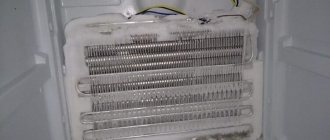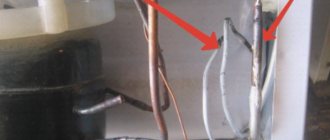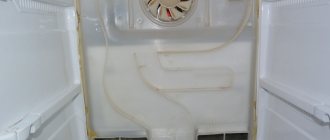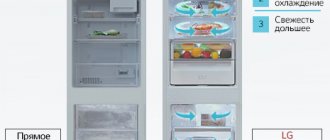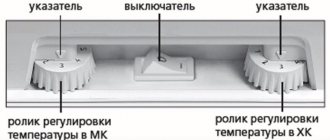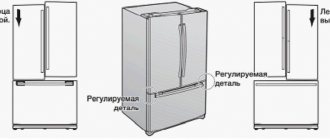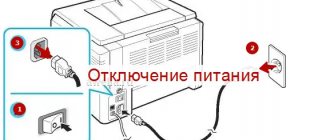Causes and signs of a refrigerant leak
By some signs you can find out how to determine a freon leak:
- The quality of system cooling gradually decreases. The equipment does not freeze well, and the food is poorly refrigerated.
- Continuous operation of the compressor with rare breaks, which is important when there is insufficient cooling.
- The compressor does not start and there is no cooling due to a freon leak in the refrigerator.
- Information about the problem appears on the small screen. Some models have indicators that flash red.
Upon preliminary inspection, you can notice a layer of snow on the evaporator, which appears in a short time. If you can’t figure out what the problem is on your own. It is better to contact specialists who will tell you how to understand that freon has leaked from the refrigerator and will help you get rid of the problem.
Snow on the evaporator
The main reason that freon leaked was non-compliance with certain operating rules:
- inaccurate transportation and unloading causes destruction of the seams;
- using a knife or fork to speed up defrosting can damage the tubes;
- lack of regular defrosting leads to ice accumulation and gradual rusting;
- long service life and corrosion;
- fulfillment of defects at the factory.
If there is little refrigerant, the compressor runs constantly, but the chamber is warm. A technician with a special tool can understand what happened and find the breakdown.
Checking system pressure
If the leak is not eliminated in a timely manner, problems with the functioning of the equipment and subsequent failure may occur. If moisture leaks into the circuit, acid will appear, which will cause corrosion and combustion of the windings in the compressor. A lack of cooling component allows air to enter the system. When refrigerant leaks, oil may also leak. Lack of cooling provokes overheating of the main device and its failure.
All these consequences of a lack of a cooling component greatly reduce the service life of the equipment.
What does the refrigerant smell like in a refrigerator when it leaks?
Modern refrigerants do not have a pronounced odor. Until the 70-80s of the 20th century, everything was different. Substances with a distinct, sometimes quite pungent odor were used in refrigerators. These were:
- Ammonia (R717);
- Chloromethane (R40);
- Sulfur dioxide.
In 1930-1935, R12 refrigerant, difluorodichloromethane, was invented. It began to be used in refrigerators and car air conditioners. Since 1994, equipment for this freon has not been manufactured. But if you have an old refrigerator using 12 freon, when there is a leak, you will notice a slight sweetish smell.
But modern freons can also smell. In their pure form they do not give off a smell, but under certain conditions... We will talk about this below.
Odorant in refrigerants
Some manufacturers add an odorant to refrigerants. They do this for safety reasons so that the smell can alert them to a leak. If your refrigerator runs on R-290 (propane), R-600a (isobutane), or a mixture of both, the smell of gas indicates a leak. The manufacturer could add an odorant to freon, similar to what is added to gas.
An odorant (from the Latin odor “smell”) is a substance used as an admixture to a gas to give it an odor, mostly a warning one. In high concentrations, all odorants are poisonous...
Definition of odorant on Wikipedia
Finding out what refrigerant your refrigerator runs on is easy. Look for a paper sticker in the main camera. It will indicate the type of refrigerant and other technical characteristics. If not there, the nameplate may be on the back wall. And it’s definitely on the compressor.
Is the compressor burning out?
If your refrigerator smells like burning, burnt oil or plastic, you're in trouble. There may be two reasons:
- The electrical wiring overheats, which can lead to a short circuit;
- There is a freon leak and the compressor is overheating due to working too hard.
When refrigerant leaks, the pressure in the system drops. To ensure normal cooling capacity, the compressor must run faster and turn on more often. In this case, the oil burns, the moving parts of the compressor wear out due to insufficient lubrication. As a result, a smell appears.
Poor quality freon
The production of refrigerants is a complex process. Achieving 100% gas purity is almost impossible. Depending on the type of refrigerant, it may contain up to 50 impurities. In high-quality freon, their content (in total) does not exceed 0.5%. In low-quality they can be up to 2.5%.
Many impurities can produce an odor when leaked. It is impossible to say which one, it depends on the type of substance and its percentage.
Excerpt from the certificate of conformity for R134a refrigerant
Replacement, refueling, refueling
If your refrigerator was repaired and a smell appeared after a while, the problem may be with the repairman. When you need to refill or top up freon, the right brand may not be at hand. Then some refrigeration companies use analogues and substitutes. However, they do not comply with the replacement conditions, for example:
- Do not purge the system of oil residues;
- The refrigerant is topped up rather than completely replaced;
- The temperature glide of the mixture of old and new refrigerant is not taken into account;
- They leave behind old oil that is not compatible with the new refrigerant.
If the type of freon is changed, the old refrigerant is refilled, or the refrigerant is completely refilled, the consequences may be different. Such work can cause breakage of copper tubes, breakdown of the compressor, thermostatic valve, etc. If the freon line breaks, the refrigerant can smell anything.
In this article, we told you what color freon from a refrigerator can be and what it smells like. It is difficult to describe all cases in one publication. We have tried to cover the most common causes of color and odor in refrigerant. We hope the information was useful to you. Don't forget to share the post with your friends and colleagues !
Do you want to get help from a master, a specialist in this field? Go to the professional search portal. This is a completely free service where you will find a professional who will solve your problem. You do not pay for posting an ad, views, or choosing a contractor. If you are a master of your craft, then register on Pro and receive a flow of clients. Your profit is just one click away!
Latest publications
- Which freezer is better, No Frost or regular?
- Top 10 air conditioners for apartments 2020-2021
- 30+ reasons: Why the refrigerator makes strange sounds, how to fix the problem
- 6 brands and 6 models: Which refrigerator to buy, inexpensive but good, with No Frost
- 20+ reasons: Why the refrigerator works but does not freeze, what is the problem, how to fix it
- Atlant, Biryusa, Indesit - which refrigerator is better and why
- Is it possible to place a refrigerator next to the stove? How to protect your refrigerator?
- TOP 10 best manufacturers and brands of refrigerators today
- Freon R407c - characteristics, features of use and replacement
- 13 reasons why the refrigerator constantly works and does not turn off
How to find a freon leak in a refrigerator yourself at home
The appearance of an unpleasant odor is evidence of refrigerant leakage. Although the freon from the refrigerator does not smell anything, when it evaporates, the microclimate in the device changes, and pathogenic microorganisms are formed that cause the odor. A heavy odor may be caused by a clogged drainage system. In this case, it is enough to clean the capillary tubes. Unpleasant odors also occur when equipment is not properly maintained. If there is a burning smell, most likely the compressor has broken down due to a lack of refrigerant.
Therefore, it is impossible to know exactly what kind of smell freon has, but to identify the problem you need to perform the following steps:
- Monitor the operation of the compressor to note the start time.
- Inspect the tightness of the seal along the contour. You should try pulling a thin strip of paper through the closed door. If this is difficult to do, the seal is fine.
- It is important to check the network. If there is a power failure, there will be no compression.
In such situations, the problem does not arise from a refrigerant leak. You can do simple manipulations at home; if the problem persists, you need to seek professional help.
Search in accessible places
To find leaks in accessible places, specialists use the following methods:
- use a foam solution where oil stains appear;
- use liquid. This method allows you to identify depressurization of removable elements. The device is filled with nitrogen, sealed and lowered into water. Additionally, soap is added;
- A halogen device is used to help detect the leakage of refrigerant containing chlorine. The device is effective in detecting small cracks;
- ultraviolet dyes are poured into the device;
- Punctures can be detected using high pressure. If the pressure is insufficient, filling with dry nitrogen is used. When it leaves the system, you can hear a noise at the crack site;
- Ultrasound diagnostics detect leakage sounds that humans cannot hear. A special device will help if there is pressure in the system.
Soap solution test
Effective methods include a test with a soap solution. It is very easy to make, but can also be purchased in stores. This may be a solution in an aerosol package or a product with added additives or in a set with brushes. After completing the spray application procedure, you must remember to remove its residues, as they contain corrosive active ingredients.
Search in hidden places
Difficulties arise with internal leaks. You can notice the problem by the swollen walls. And to determine hidden leaks, an electronic leak detector is used. This mechanism reveals small cracks.
What does a freon leak look like in a refrigerator?
If refrigerant is leaking, this can be determined by inspection. The breakout area becomes a black spot and oil remains around. If the puncture is in the closed part, the chamber wall will swell.
If freon leaks from the refrigerator, the chamber will be warm and an oily puddle will appear on the floor. When the refrigerant enters the room, it evaporates and leaves behind oil, condensate and decomposition products. The cold grille on the front side is also an indicator.
The specialist knows exactly how to find a freon leak in the refrigerator. For this purpose, there is a special device that sounds a sound signal when a violation of integrity is detected.
Internal freon leak in refrigerator
Difficulties arise if a freon leak occurs inside the device. In such a situation, it is necessary to change the refrigerant circuit. If there is a breakthrough in the door circuit, the tube is laid along the rear surface. If there is a breakthrough in the housing, the specialist removes the insulation and makes the circuit again. It is very difficult to restore the operation of equipment after such a breakdown. And some companies that have a refrigerator under warranty do not repair the equipment, but provide a replacement.
Leak inside refrigerator
How to carry out preventative maintenance on a car air conditioner?
It’s one thing to get rid of an unpleasant odor in the car interior; it’s another thing to prevent such a situation from occurring and prevent similar situations. First of all, keep an eye on the cabin filter, clean it on time or replace it with a new one. Remember, by buying a cheap filter, you will not save money, but on the contrary, you will speed up the process of mold growth, so you should not skimp on such parts.
The second rule, even more important than the first, is to dry the air conditioner evaporator before you park the car for a long time (overnight in a garage, parking lot or other room). Therefore, it is highly recommended to calculate the time of use of the car air conditioner and from the moment the air conditioner is turned off until the engine is turned off, 3-5 minutes should pass, preferably 10-15 minutes. To do this, turn off the air conditioner, but leave the fan running; the air flow will dry the evaporator. Accordingly, there will be no collection of bacteria and moisture.
The appearance of an unpleasant odor is, first of all, an indicator that it is time to look at the cabin filter, as well as clean the evaporator. On the other hand, this is an indicator that the car air conditioner is not looked after or used incorrectly. Therefore, you should not postpone the maintenance of the cabin evaporator until later, as there may be an irreversible process that will cost a decent amount.
Video review of cleaning a car air conditioner:
Source
Fixing a freon leak in a refrigerator
Various methods are used to restore tightness. Soldering is used to repair damage in the evaporator. Argon welding is used to join aluminum and copper pipes. In some cases, the leak occurs at the junction of the compressor and the fitting, and the circuit may not require repair. To troubleshoot the problem, the specialist performs the following steps:
- Carrying out diagnostics. The technician must understand why freon is leaking from the refrigerator.
- Detection of cracks and punctures in circuit tubes.
- To remove residual refrigerant and condensate, the system is evacuated.
- The circuit is filled with gas in the required volume.
- The technician must check the equipment for leaks.
Repairing Freon Leaks
Even after pumping in freon, the cooling effect may not be fully restored. May need refilling.
Soldering
To eliminate cracks, a soldering method is used, which includes the following manipulations:
- The soldering area is carefully prepared. To do this, insulation is carried out using asbestos gaskets that protect the elements from the burners;
- puncture areas are sealed with solder with a silver base and a special paste;
- dryer filters are being replaced;
- The treated areas are checked for leaks.
If the sealing is done correctly, the specialist proceeds to filling the circuit with freon. Injection is carried out through the Schrader valve. The refrigerant is taken from a special cylinder.
Without repair
In cases where the breakdown is associated with clogged filters or capillary pipes, no repairs are made. To get rid of the problem, just clean it. If liquid has entered the cooling circuit, you will need to remove the filter drier. After fixing the problem, it is necessary to restore the required amount of gas. Refueling should be done by specialists. After refueling, you need to check the functionality of the cameras. If the tubes that enter the circuit begin to freeze, it means that freon has been added in excess.
Excess freon
Leak testing is also performed. If necessary, moisture is removed from the circuit. A vacuum device is used for this.
Types of freons for refrigerators
- R 600 a – (isobutane) the most common refrigerant for modern refrigerators. It is a colorless volatile substance that is part of natural gas.
R 600a does not pose a danger to people and the environment under normal conditions.
An exception may be a closed room with a large amount of gas, in which case a person may suffocate due to lack of oxygen. But such an outcome is impossible, since there is only 100 - 200 grams of gas in the refrigerator.
Refrigerant R600a
Isobutane creates an explosive mixture with air. The lower fire hazard threshold is 1.3%, which is 31 grams per 1 m3. The volume of the smallest kitchen with an area of about 6 m2 is 15 m3. It follows that there is a danger of explosion when the kitchen is filled with more than 400 grams. isobutane and a complete lack of ventilation. Since the gas content is no more than 200 g, there is no danger of explosion even when the gas stove or oven is running.
- R 134 a – (tetrafluoroethane). One of the first chlorine-free coolants. It is colorless and odorless. It is considered the safest for the environment, as it does not emit chlorine or bromine, which can destroy the ozone layer. Ozone Depletion Potential (ODP) is zero.
R134a is the safest of modern refrigerants for humans. It is non-explosive and non-toxic.
- R12 – (difluorodichloromethane). Can only be found in older models of refrigerators. It is not used now, as it has a detrimental effect on the ozone layer due to the release of chlorine. A colorless gas with a slight ether odor, non-flammable.
Refrigerant R12
Refrigerant R12 (chemical formula)
R12 is not dangerous for humans in domestic conditions.
In industrial areas, concentrations greater than 30% cause suffocation. At high temperatures (over 3300C) it can decompose with the release of hydrogen chloride (hazard class 2), hydrogen fluoride (class 1), carbon monoxide, phosgene and other hazardous substances. Difluorochloromethane itself belongs to hazard class 4.
- R22 – (difluorochloromethane). Refrigerant of the previous generation.
Colorless gas, smells like chloroform. Less harmful to the environment than R12, since its molecule contains only one chlorine atom. The level of ozone destruction is 20 times lower than for R12. Belongs to hazard class 4.
R22 (difluorochloromethane) at normal temperatures is not dangerous to humans. When heated to 250 degrees, it releases toxic gases.
If liquid freon comes into contact with the skin, frostbite may occur. Blisters appear on the skin, as if from regular burns.
All freons that are used in refrigeration units are not toxic to humans under normal operating conditions. Potential danger can be created in hermetically sealed rooms and in the presence of very high temperatures (more than 2000C).
Freons themselves are less dangerous to humans than their decay products. During combustion, any of these gases can decompose and release harmful substances. But it is almost impossible to achieve the process of freon ignition in domestic conditions (the only exceptions are emergency situations!).
At high concentrations, refrigerants have a narcotic effect. As a result of prolonged inhalation, a person may feel drowsiness, confusion, and weakness. In rare cases, the body may be poisoned by vapors of decay products.
How to determine what freon is in your refrigerator
Freons consist of a mixture of ethane and methane, in which hydrogen atoms are used instead of chlorine and fluorine atoms. In a refrigerator, the refrigerant evaporates and condenses into a liquid. As a result, cooling occurs. The industry produces more than 40 varieties of freons. But only some of them are used for household appliances.
To find out what kind of freon is in the refrigerator, you need to look at the technical documentation. Here manufacturers indicate the characteristics of the equipment. The type of refrigerant is also indicated on the compressor.
Initially, R 12 freon was used in refrigerators. It was used in the production of models such as Zil and Dnepr. This substance was highly effective, but was banned due to its low environmental friendliness. Among the advantages, it is worth noting the low cost, the ability to replace with other refrigerants and high performance. The disadvantage is the high noise level.
R12 was replaced by R134A or tetrafluoroethane. When this refrigerant is used, the compressors use synthetic oil. This component does not dissolve oil well, as a result of which it is not completely returned to the compressor. This causes blockages in the capillary pipes. Among the advantages, it is worth noting the high cooling capacity. There are also some disadvantages. Freon cannot be replaced with other alternatives.
The new refrigerants include R600A, which is suitable for class A equipment. Equipment running on this freon is characterized by low energy consumption and noise. This was achieved through the use of compressors with reduced power levels. The disadvantages of the refrigerant include the risk of explosion, but this component is so small that it is not dangerous for users. When repairing equipment with such a refrigerant, fire safety regulations must be observed. The advantages include the possibility of replacement with other refrigerants.
Application of freon
Freon is used as a refrigerant due to its physical properties - it absorbs heat during evaporation and then releases it during condensation. The operating principle is as follows: in refrigeration equipment, freon in a gaseous state is extracted (sucked out) from the evaporator using a compressor, compressed into a mechanically reduced volume (in a piston compressor in a cylinder - by a piston), with simultaneous heating and transported to the condenser. There the freon cools down to the temperature of the air around it and turns into a liquid state. Liquid freon flows through a throttling device (capillary tube or Thermostatic Valve - TEV) into the evaporator, expands due to the low pressure after the throttling device, and again turns into a gaseous state. The expansion process is accompanied by the absorption of a large amount of heat, as a result of which the walls of the evaporator (the container in which freon boils and evaporates) are cooled, lowering the air temperature inside the cooled volume.
We recommend: DIY shabby chic: crafts and interior design techniques
The cycle is repeated until the temperature of the evaporator walls drops to the value set by the thermostat, after which the thermostat opens the electrical circuit of the compressor and it stops working. After some time, under the influence of various factors, the air in the refrigeration chamber heats up, and the thermostat turns on the compressor again. Freon has been used as a coolant in any refrigeration equipment and air conditioners since 1931 (before that, ammonia, which is harmful to health, was used). Also, due to its thermodynamic properties, the refrigerant is used in perfumery and medicine to create aerosols. Freon is widely used when extinguishing fires at hazardous facilities.
Where is the highest probability of leaks?
Refilling equipment with freon is not that difficult. But to carry out repairs, it is necessary to correctly determine the location of the leak. To quickly determine the presence of cracks, it is important to know the problem areas in the equipment:
- Pipe soldering areas. The internal contour consists of elements that are joined by soldering. During the production process, joints may be welded poorly. As a result, small cracks appear at the joints, through which coolant slowly flows out.
- An evaporator that is placed inside the equipment. It is made from thin metal. When leaks appear, a layer of frost appears on the surface of the device. After removing it, you can fix the problem. A crack is difficult to repair if it is on the inside.
- Freon circulates in the heating circuit. Gas flows inside the system from the internal chambers and to the compressor. As a result, excess heat is removed. This device is used to eliminate condensation, so corrosion may occur.
Once the leak is detected, the problem can be fixed. If you have the skills, the problem can be fixed on your own. But in order for the work to be done efficiently, it is worth contacting a specialist.
